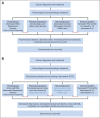Psychosocial telephone counseling for survivors of cervical cancer: results of a randomized biobehavioral trial
- PMID: 25713429
- PMCID: PMC4372853
- DOI: 10.1200/JCO.2014.57.4079
Psychosocial telephone counseling for survivors of cervical cancer: results of a randomized biobehavioral trial
Abstract
Purpose: Survivors of cervical cancer experience quality-of-life (QOL) disruptions that persist years after treatment. This study examines the effect of a psychosocial telephone counseling (PTC) intervention on QOL domains and associations with biomarkers.
Patients and methods: We conducted a randomized clinical trial in survivors of cervical cancer, who were ≥ 9 and less than 30 months from diagnosis (n = 204), to compare PTC to usual care (UC). PTC included five weekly sessions and a 1-month booster. Patient-reported outcomes (PROs) and biospecimens were collected at baseline and 4 and 9 months after enrollment. Changes in PROs over time and associations with longitudinal change in cytokines as categorical variables were analyzed using multivariable analysis of variance for repeated measures.
Results: Participant mean age was 43 years; 40% of women were Hispanic, and 51% were non-Hispanic white. Adjusting for age and baseline scores, participants receiving PTC had significantly improved depression and improved gynecologic and cancer-specific concerns at 4 months compared with UC participants (all P < .05); significant differences in gynecologic and cancer-specific concerns (P < .05) were sustained at 9 months. Longitudinal change in overall QOL and anxiety did not reach statistical significance. Participants with decreasing interleukin (IL) -4, IL-5, IL-10, and IL-13 had significantly greater improvement in QOL than those with increasing cytokine levels.
Conclusion: This trial confirms that PTC benefits mood and QOL cancer-specific and gynecologic concerns for a multiethnic underserved population of survivors of cancer. The improvement in PROs with decreases in T-helper type 2 and counter-regulatory cytokines supports a potential biobehavioral pathway relevant to cancer survivorship.
Trial registration: ClinicalTrials.gov NCT00496106.
© 2015 by American Society of Clinical Oncology.
Conflict of interest statement
Authors' disclosures of potential conflicts of interest are found in the article online at
Figures




References
-
- Ashing-Giwa KT, Kim J, Tejero JS. Measuring quality of life among cervical cancer survivors: Preliminary assessment of instrumentation validity in a cross-cultural study. Qual Life Res. 2008;17:147–157. - PubMed
-
- Bergmark K, Avall-Lundqvist E, Dickman PW, et al. Vaginal changes and sexuality in women with a history of cervical cancer. N Engl J Med. 1999;340:1383–1389. - PubMed
-
- Bergmark K, Avall-Lundqvist E, Dickman PW, et al. Lymphedema and bladder-emptying difficulties after radical hysterectomy for early cervical cancer and among population controls. Int J Gynecol Cancer. 2006;16:1130–1139. - PubMed
-
- Bradley S, Rose S, Lutgendorf S, et al. Quality of life and mental health in cervical and endometrial cancer survivors. Gynecol Oncol. 2006;100:479–486. - PubMed
Publication types
MeSH terms
Substances
Associated data
Grants and funding
LinkOut - more resources
Full Text Sources
Medical
Miscellaneous

